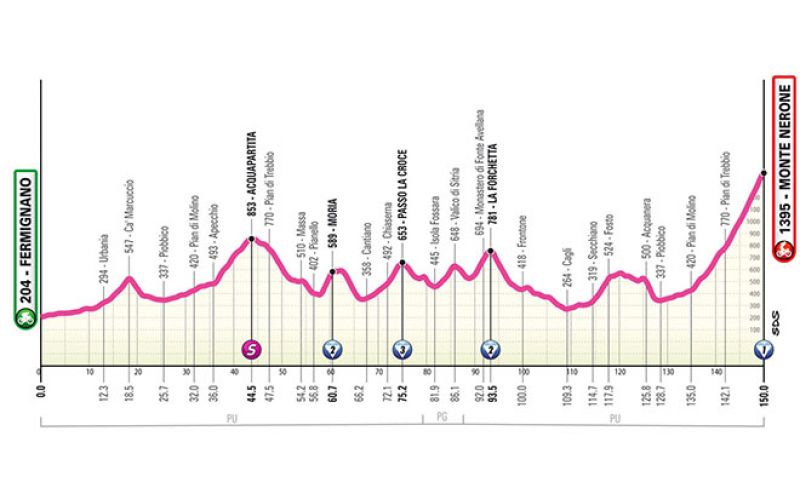

The queen stage of the 2025 edition - the Fermignano - Monte Nerone of 150 km - is also the longest of the planned stages and will certainly call upon climbers and all the general classification contenders.
to follow the live coverage of the entire stage starting at 9:50 AM CLICK HERE
The start from Fermignano is already uphill, but the first of the 4 mountain passes will only be after 60 kilometers. The central part of the race is expected to be heated with the climbs of Moria, Passo La Croce, and La Forchetta within 30 km. After a brief up and down section, the ascent to Monte Nerone will begin 15 km from the finish line. It's a regular climb with an average of 6.7%, but there are sections that exceed 12% and could truly cause pain.
TERRITORY. The seventh stage of the Giro Women takes place entirely in the Marche region, which will probably be decisive for the overall victory of the race. But before tackling the severe final climb, the athletes will get to know the hills of the Pesaro hinterland and the Metauro Valley, lands of great landscape interest characterized by rare beautiful villages.
Fermignano, the starting location overlooking the Metauro banks, is of Roman origin and boasts a small but significant historic center that preserves its most beautiful architectures: the Medieval Tower of the Militias, the beautiful three-arch bridge crossing the Metauro, the architecture museum, and the washhouses, with an unparalleled view of the suggestive waterfall.
The next stage is Urbania, the ancient Casteldurante, famous since the Renaissance for artistic ceramic production and the sumptuous 15th-century Ducal Palace. Also worth seeing is the Bramante Theater: with three tiers of boxes and a gallery, it is one of the jewels of the Marche Region, built on the foundations of a 14th-century fortress and completely renovated in 1726.
The first passage through Piobbico, at the foot of Monte Nerone, allows relaxation in the medieval historic center dominated by Palazzo Brancaleoni, which attracts attention for its dimensions and various architectural styles that harmoniously overlap. Inside, a rich geo-paleontological collection, Brancaleoni family clothes and jewels, the honor courtyard, and the Greek Room can be admired.
One walks through the Middle Ages also in Apecchio, known by gourmets for being one of the capitals of Marche truffles. A brief visit can start from the medieval humpback bridge from the 1400s that leads to the arch of the 14th-century bell tower. Nearby is Palazzo Ubaldini, which houses the G. Perugini theater, the smallest in the Marche, and the Museum of Fossils and Minerals of Monte Nerone, boasting a collection of over two thousand pieces of great beauty and scientific importance. Notable is also the Church of Santa Lucia of Templar origins with frescoes of the Giotto school.
The next stage is the extraordinary Eremo di Fonte Avellana, one of the most historically rich abbeys in the Apennines. Founded in 980, it is impressive for its solitary position and elegant Romanesque-Gothic architectures. Well-restored, it preserves a simple and elegant church, a robust bell tower from 1482, and some beautiful rooms from the 16th and 17th centuries.
In Cagli, one stops to visit the Rocca Torrione (1481) in whose underground is the "covered rescue", a path with 367 steps, which reaches the overlying Rocca, where now stands the Capuchin Convent and the Church of San Francesco (1234), considered the oldest in the Marche. It is accessed through a grandiose marble portal while inside the Gothic style dominates.
Back in Piobbico, the athletes begin the climb leading to the Monte Nerone finish line, a realm of trekking, but also well-known for its caves that attract caving enthusiasts. A place that every mountain sports follower must underline with a red pencil.

Se sei giá nostro utente esegui il login altrimenti registrati.